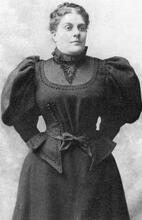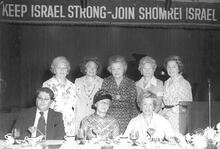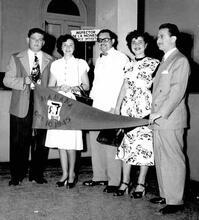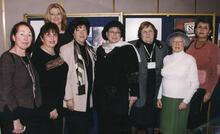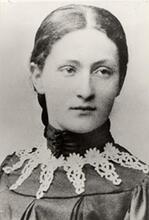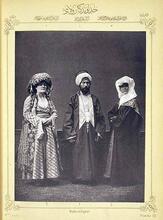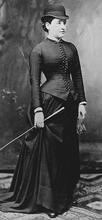Esther Loeb Kohn
Esther Loeb Kohn helped bridge the gap between Chicago’s volunteer and professional social workers and spent thirty years running the Hull House settlement whenever founder Jane Addams was away on her frequent travels. Kohn left school at fifteen to help raise her younger siblings, but after marrying medical student Alfred D. Kohn in 1894 she studied at the University of Chicago and took voice-training classes in Munich, Paris, and Vienna. After her husband’s sudden death in 1909, she became a Hull House resident and quickly rose through the ranks of volunteers, becoming an administrator and organizing summer camp and children’s activities. Meanwhile, she served as director, vice president, and president of the Social Service Bureau of Jewish Charities from 1921 to 1941 and helped organize the Jewish Vocational and Employment Service’s Work Shop for Handicapped Persons.
“The great need today is for social inventions for the prevention of destitution and illness.” This statement, made in 1938, illustrates two of the primary interests of Esther Loeb Kohn’s life—social reform and medical social work. A thirty-year resident of Hull House, the famous Chicago social settlement founded by Jane Addams, Kohn was also an active volunteer and financial supporter of Jewish charitable organizations in Chicago. A “professional board lady,” in addition to her work on behalf of child welfare she devoted great effort to bridging the gap between volunteer and professional social workers.
Family and Education
Esther Loeb Kohn came from the old-line, well-to-do, German Jewish Loeb family. The daughter of Emma (Mannheimer) and William Loeb, a former captain in the Civil War, she was born on Chicago’s Near North Side on January 12, 1875. The second-oldest child of seven and the eldest daughter, Kohn left school at age fifteen to help raise her younger siblings. She had a fine singing voice and, while still a youth, was invited by Theodore Thomas, who later established the Chicago Symphony, to sing with his Apollo Club.
In December 1894, at age nineteen, Esther Loeb married Alfred D. Kohn. He possessed a Ph.D. in English but decided to attend medical school, and the couple later went to Germany, where he completed his training. Rather than retiring to her home after marriage, Esther Loeb Kohn took courses at the University of Chicago. While in Europe, she took advantage of the opportunity to further her musical training in Munich and Paris and also attended the University of Vienna. When the couple returned to Chicago, Kohn continued her education, taking courses at the School of Civics and Philanthropy, from which she eventually received a certificate. Later, in 1920, she played an important role in the merger of the school into the School of Social Service Administration at the University of Chicago.
Work and Meeting Jane Addams
A member of the Chicago Board of Education, Alfred Kohn started the first nutrition program in the Chicago public schools, work that brought him into contact with Jane Addams. When he died suddenly in December 1909 at age thirty-seven, Esther Kohn had never met Addams personally but, nevertheless, decided to devote her energies to social service by becoming a Hull House resident. Realizing her administrative and organizational ability, Addams placed Kohn in charge of Hull House whenever she herself was not in residence, an occurrence that became more frequent with the passing years.
Always a supporter of Jewish causes, Kohn served as director, vice president, and president of the Jewish Social Service Bureau of Jewish Charities from 1921 to 1941. She was on the board of the Jewish Vocational and Employment Service and was instrumental in organizing the Work Shop for Handicapped Persons. She was also a board member and later president of the Board of the Scholarship Association for Jewish Children. In the 1930s, Kohn became a member of various groups engaged in rescuing victims of Nazi tyranny, and later she was active in the Chicago Committee on Displaced Persons and the American-Jewish Joint Distribution Committee, organizations that helped displaced persons admitted to the United States. A confirmed pacifist, Kohn had attended the 1921 peace conference in Vienna under the auspices of the International League for Peace and Freedom. In the 1930s, she backed groups such as the Chicago Committee Against Rearming Europe, and she opposed peacetime conscription following World War II. Concerned with the fate of children of working mothers, during the war Kohn was active in the Committee on War Problems.
Placed in charge of children’s activities and the summer camp at Waukegan, Illinois, upon her arrival at Hull House, Kohn directed the volunteer movement and initiated a trade school for girls forced to leave school and seek employment. Later she persuaded the Chicago Board of Education to adopt the program for the city school system. It developed into the Vocational Guidance program and the Scholarship and Guidance Association, established in 1911. Immediately attracted to the Immigrants Protective League, Kohn became a board member in 1911. She remained a member of the board for fifty years, becoming chair of its finance committee.
Through her husband’s profession, Kohn became interested in the medical social work field and was in its vanguard. She recommended that trained laypeople help medical social workers so that the professionals could be freed for large-scale “community planning for health and well-being,” and she organized voluntary programs in various Chicago area hospitals.
With the growing professionalization of Hull House, Kohn became a link between volunteer and professional social workers. When a power struggle developed over control of the settlement after Jane Addams’s death in 1935, Kohn was one of the committee members whom residents selected to work with the board in choosing a new head resident. When the board failed to consult the residents, however, Kohn disapproved of the changes and left Hull House in 1941. She and a widowed sister moved to a fashionable apartment where Kohn lived until her death and from which she continued to pursue her multiple activities. Always interested in politics, she financially backed liberal candidates, especially Adlai Stevenson, with whom she became friends. In later years, Kohn and Stevenson became the only honorary board members of the Immigrants Protective League.
Legacy and Awards
Kohn was shy in front of large groups and never sought the limelight for herself. Toward the end of her long life, she began to receive recognition for her achievements as honors and awards were showered upon her. The Institute of Medicine of Chicago made her a Citizen Fellow in 1956 and reelected her to their board after her ninetieth birthday. She received the Golden Age Hall of Fame Award from the Jewish Community Centers of Chicago in 1960. Honored by the Immigrants Protective League in 1955 and 1959, she was named Sweetest Woman of the Year in 1960. In the spring of 1961, the Immigrants Service League, as the IPL was called by then, established the annual Esther L. Kohn Award, given each year to a native-born citizen who has helped immigrants. Active until the end, Esther Loeb Kohn died at age ninety on September 1, 1965.
Esther Loeb Kohn devoted her life to helping those less fortunate. Although she was a recognized expert in the child welfare and medical social work fields, financial security allowed Kohn to perform all her service as a volunteer. She was thus in a unique position to act as a link between the professionals and volunteers in Chicago social welfare organizations. Kohn, consequently, was an important figure in both Chicago’s secular and Jewish communities.
Abbott, Edith, and Grace Abbott. Papers. University of Chicago.
BEOAJ; Kohn, Esther Loeb, and Adela Miller Rich. Papers. Jane Addams Memorial Collection, University of Illinois at Chicago.

